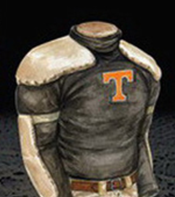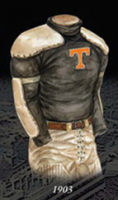VFL-82-JP
Bleedin' Orange...
- Joined
- Jan 17, 2015
- Messages
- 20,654
- Likes
- 57,408
Let's have another go, picking up where we left off:
One note about the early Volunteers uniforms -- this poster is popular, and I've always thought it to be accurate.

But one has to wonder about the Power T on the chest of the 1903 uniform, since the emblem reportedly first appeared in 1964. According to school tradition, coach Doug Dickey added the block T for the first time when he replaced numerals on the sides of players' helmets with the logo, then a year later talked the Pride of the Southland Band into forming a T on the field for our players to run through while entering the stadium. If that is true, how was an orange T on the chest of the black jersey 60 years earlier (not to mention that T looks awfully modern, with its sculpted inside edges)?

Dunno. No idea which version of history is accurate. But we do know for a fact that the lads were wearing black while playing for the coaches we're about to discuss.
 #4 -- Saxton Daryl "Sax" Crawford, 1904 --
#4 -- Saxton Daryl "Sax" Crawford, 1904 --
With the most interesting nickname of the early Tennessee coaches, Sax was the first native son to coach the Volunteers, having played quarterback as a Vol in 1901 and 1902. Crawford was a multi-sport athlete, like several others on this list: he played football, baseball, basketball, and ran track. Crawford's greatest claim to fame was being the first coach to win against the Alabama Crimson Tide. The score was 5-0 in the Vols' favor, and was the third meeting of the schools, resulting in a series record of 1-1-1. Unfortunately, Sax wasn't quite so successful as our coach the rest of the season, ending with a 3-5-1 record (.389). A couple of years later, he would coach the North Georgia Agricultural College's football team for a season; he had no other coaching experience. A businessman, he was briefly enlisted in September 1918, just as the first World War was winding down. Never having to actually serve overseas, he was discharged two months later and went back to manufacturing. He married Mary Kirkpatrick and with her had three children.
 #5 -- James "JD" DePree 1905-1906 --
#5 -- James "JD" DePree 1905-1906 --
JD was a Michigan man. Born in the town of Holland, Michigan, he played fullback for the Wolverines before heading south to Knoxville. Football was not his only passion; he coached our baseball team as well, and founded the school's basketball program. While energetic, JD wasn't very successful on the gridiron. His first football squad went 3-5-1 (0-4-1 in conference) and his second year was even worse, at 1-6-2 (0-4-1 again in conference), for a career record of 4-11-3 (.306). Little else is known about the coach, only that he married Knoxville native Fannie Wilson and had three sons. He died in 1972 without, as far as I could tell, ever coaching again. Wouldn't it be amazing if a member of his family were to join us here and provide more detail on his life? (can wish the same for each of our former coaches).
 #6 -- George "Izzy" Levene, 1907-1909 --
#6 -- George "Izzy" Levene, 1907-1909 --
Levene may have been the first professional coach for the Vols, by which we mean the first paid coach and the first who made at least a partial career out of coaching. He played football at the University of Pennsylvania, where he was an All-American in 1905 and 1906. He was one of the first pass-catching ends (the forward pass was legalized in 1906, though it wouldn't become widely used or popular for a couple of decades). After graduating, Izzy served as assistant coach under John Heisman (yes, that Heisman) also at U Penn. A year later, he took the head coaching position at Tennessee. Following the pattern set by every Vols coach before him who served more than a single season, he started out better than he finished. In 1907 he went 7-2-1 (3-2-1 in conference), followed by a 7-2 (4-2) result the following year. He closed out his time in Knoxville with a 1-6-2 (0-5) disaster of a 1909 outing. Overall, his Tennessee record was an unremarkable 15-10-3 (.589). Izzy did continue to coach, interspersing stints back at U Penn (ends coach) and one season as head coach for Wake Forest (1922) with time as a referee. He also wrote a book about football, entitled Twenty Modern Football Plays. He died young, in 1930, at the age of 45.
 #7 -- Andrew Alexis "Lex" Stone, 1910 --
#7 -- Andrew Alexis "Lex" Stone, 1910 --
Lex Stone was born in Dellrose, Tennessee, in Lincoln County just north of the Alabama border. He played lineman (left tackle) for Sewanee, which was a prominent program at the time (Sewanee were in the same conference as Tennessee, the Southern Intercollegiate Athletic Association, and won three conference titles between 1898 and 1909). After graduating, Stone moved to Knoxville and took over both the football and basketball teams--interestingly, he only coached football in 1910, but stayed with the basketball team a second year. Results were not fantastic: 3-5-1 overall, 1-4 in conference (.389). It is quite possible that Stone was in Knoxville to attend law school, like several of his predecessors, as he went on to serve a career in state politics (little detail, but it is known that he represented Lincoln County in the 58th general assembly, 1913-1915). Like Levene before him, he died young: aged 39, in 1925.
~ ~ ~
That'll do it for today. Don't want to piss Behr off too much with these long posts, he hates when I do this.
Will continue the write-ups tomorrow or the next day. We're starting to get within long visual range of the General.
Go Vols!
One note about the early Volunteers uniforms -- this poster is popular, and I've always thought it to be accurate.

But one has to wonder about the Power T on the chest of the 1903 uniform, since the emblem reportedly first appeared in 1964. According to school tradition, coach Doug Dickey added the block T for the first time when he replaced numerals on the sides of players' helmets with the logo, then a year later talked the Pride of the Southland Band into forming a T on the field for our players to run through while entering the stadium. If that is true, how was an orange T on the chest of the black jersey 60 years earlier (not to mention that T looks awfully modern, with its sculpted inside edges)?

Dunno. No idea which version of history is accurate. But we do know for a fact that the lads were wearing black while playing for the coaches we're about to discuss.
 #4 -- Saxton Daryl "Sax" Crawford, 1904 --
#4 -- Saxton Daryl "Sax" Crawford, 1904 --With the most interesting nickname of the early Tennessee coaches, Sax was the first native son to coach the Volunteers, having played quarterback as a Vol in 1901 and 1902. Crawford was a multi-sport athlete, like several others on this list: he played football, baseball, basketball, and ran track. Crawford's greatest claim to fame was being the first coach to win against the Alabama Crimson Tide. The score was 5-0 in the Vols' favor, and was the third meeting of the schools, resulting in a series record of 1-1-1. Unfortunately, Sax wasn't quite so successful as our coach the rest of the season, ending with a 3-5-1 record (.389). A couple of years later, he would coach the North Georgia Agricultural College's football team for a season; he had no other coaching experience. A businessman, he was briefly enlisted in September 1918, just as the first World War was winding down. Never having to actually serve overseas, he was discharged two months later and went back to manufacturing. He married Mary Kirkpatrick and with her had three children.
 #5 -- James "JD" DePree 1905-1906 --
#5 -- James "JD" DePree 1905-1906 --JD was a Michigan man. Born in the town of Holland, Michigan, he played fullback for the Wolverines before heading south to Knoxville. Football was not his only passion; he coached our baseball team as well, and founded the school's basketball program. While energetic, JD wasn't very successful on the gridiron. His first football squad went 3-5-1 (0-4-1 in conference) and his second year was even worse, at 1-6-2 (0-4-1 again in conference), for a career record of 4-11-3 (.306). Little else is known about the coach, only that he married Knoxville native Fannie Wilson and had three sons. He died in 1972 without, as far as I could tell, ever coaching again. Wouldn't it be amazing if a member of his family were to join us here and provide more detail on his life? (can wish the same for each of our former coaches).
 #6 -- George "Izzy" Levene, 1907-1909 --
#6 -- George "Izzy" Levene, 1907-1909 --Levene may have been the first professional coach for the Vols, by which we mean the first paid coach and the first who made at least a partial career out of coaching. He played football at the University of Pennsylvania, where he was an All-American in 1905 and 1906. He was one of the first pass-catching ends (the forward pass was legalized in 1906, though it wouldn't become widely used or popular for a couple of decades). After graduating, Izzy served as assistant coach under John Heisman (yes, that Heisman) also at U Penn. A year later, he took the head coaching position at Tennessee. Following the pattern set by every Vols coach before him who served more than a single season, he started out better than he finished. In 1907 he went 7-2-1 (3-2-1 in conference), followed by a 7-2 (4-2) result the following year. He closed out his time in Knoxville with a 1-6-2 (0-5) disaster of a 1909 outing. Overall, his Tennessee record was an unremarkable 15-10-3 (.589). Izzy did continue to coach, interspersing stints back at U Penn (ends coach) and one season as head coach for Wake Forest (1922) with time as a referee. He also wrote a book about football, entitled Twenty Modern Football Plays. He died young, in 1930, at the age of 45.
 #7 -- Andrew Alexis "Lex" Stone, 1910 --
#7 -- Andrew Alexis "Lex" Stone, 1910 --Lex Stone was born in Dellrose, Tennessee, in Lincoln County just north of the Alabama border. He played lineman (left tackle) for Sewanee, which was a prominent program at the time (Sewanee were in the same conference as Tennessee, the Southern Intercollegiate Athletic Association, and won three conference titles between 1898 and 1909). After graduating, Stone moved to Knoxville and took over both the football and basketball teams--interestingly, he only coached football in 1910, but stayed with the basketball team a second year. Results were not fantastic: 3-5-1 overall, 1-4 in conference (.389). It is quite possible that Stone was in Knoxville to attend law school, like several of his predecessors, as he went on to serve a career in state politics (little detail, but it is known that he represented Lincoln County in the 58th general assembly, 1913-1915). Like Levene before him, he died young: aged 39, in 1925.
~ ~ ~
That'll do it for today. Don't want to piss Behr off too much with these long posts, he hates when I do this.
Will continue the write-ups tomorrow or the next day. We're starting to get within long visual range of the General.
Go Vols!
Attachments
Last edited:



